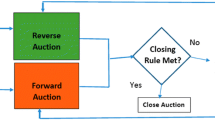Abstract
The paper is concerned with supply constraints in the provision of telecommunications services. As a measure of supply constraint we use the average waiting time for telephone connections. Duration models are employed to analyze a panel data set for 28 countries. In addition to economic variables, we consider the role of technical efficiency in causing supply constraints. Stochastic frontiers are used to determine the technical efficiency with which countries use labor and capital inputs to connect customers. When technical efficiency is included in duration models for waiting times until connection, we find that it is the major determinant.
Similar content being viewed by others
References
Aigner, D. J., C. A. K. Lovell and P. Schmidt. (1977). "Formulation and Estimation of Stochastic Frontier Production Function Models." Journal of Econometrics 6, 21-37.
Alleman, J. and A. Fontenay. (1997). Telecommunications Demand. In D. Lamberton (ed.),The New Research Frontiers in Communications Policy. North-Holland, 43-64.
Battese, G. E. and G. S. Corra. (1977). "Estimation of a Production Frontier Model: With Application to the Pastoral Zone of Eastern Australia." Australian Journal of Agricultural Economics 21, 169-179.
Bowles, D. (1995). Telephone Penetration: Industrial Countries vs. LDCs. In D. Lamberton (ed.), Beyond Competition: The Future of Telecommunications. North-Holland, 299-314.
Coelli, T. J. (1995). "Estimators and Hypothesis Tests for a Stochastic Frontier Function:AMonte Carlo Analysis." Journal of Productivity Analysis 6, 247-268.
Coelli, T. J. (1996). "A Guide to Frontier Version 4.1: A Computer Program for Frontier Production Function Estimation." CEPA Working Paper 96/08, Department of Econometrics, University of New England, Australia.
Cowan, L. (1990). Privatization in the Developing World. Contributions in Economics and Economic History, No. 112. London: Greenwood Praeger.
Crandall, R. and K. Flamm. (1989). Changing the Rules: Technological Change, International Competition, and Regulation in Communications. Washington: Brookings Institution.
Duch, R. (1991). Privatizing the Economy: Telecommunications Policy in Comparative Perspective. Ann Arbor: University of Michigan Press.
Greene, W. H. (1997). Econometric Analysis, 3rd ed. New Jersey: Prentice-Hall.
Islam, T. and D. Fiebig (2001). "Modelling the Development of Supply Restricted Telecommunications Markets." Journal of Forecasting 20, 249-264.
ITU. (1997). World Telecommunication Indicator Database. Geneva: International Telecommunication Union.
ITU. (1999). Financing Network Investment, Chapter XIV. Geneva: International Telecommunications Union.
Jain, D., V. Mahajan and E. Muller. (1991). "Innovation Diffusion in the Presence of Supply Restrictions." Marketing Science 10, 83-90.
Laffont, J. J. and J. Tirole. (1993). A Theory of Incentives in Procurement and Regulations, Cambridge, MA: MIT Press.
Maddock, R. (1997). Telecommunications and Economic Development. In D. Lamberton (ed.), The New Research Frontiers in Communications Policy. North-Holland, 159-175.
Meeusen, W. and J.v.d. Broeck. (1977). "Efficiency Estimation from Cobb-Douglas Production Functions with Composed Error." International Economic Review 18, 435-444.
Pitt, M. M. and L. F. Lee. (1981). "Measurement and Sources of Technical Inefficiency in the IndonesianWeaving Industry." Journal of Development Economics 9, 43-64.
Simon, H. and K. Sebastian. (1987). "Diffusion and Advertising: The German Telephone Campaign." Management Science 33, 451-466.
Summers, R. and A. Heston. (1991). "The PennWorld Table, Mark 5: An Expanded Set of International Comparison, 1950-1988." The Quarterly Journal of Economics, 327-368.
Taylor, L.D. (1994). Telecommunications Demand in Theory and Practice. London: Kluwer Academic Publishers.
Author information
Authors and Affiliations
Rights and permissions
About this article
Cite this article
Bartels, R., Islam, T. Supply Restricted Telecommunications Markets: The Effect of Technical Efficiency on Waiting Times. Journal of Productivity Analysis 18, 161–169 (2002). https://doi.org/10.1023/A:1016586321699
Issue Date:
DOI: https://doi.org/10.1023/A:1016586321699



